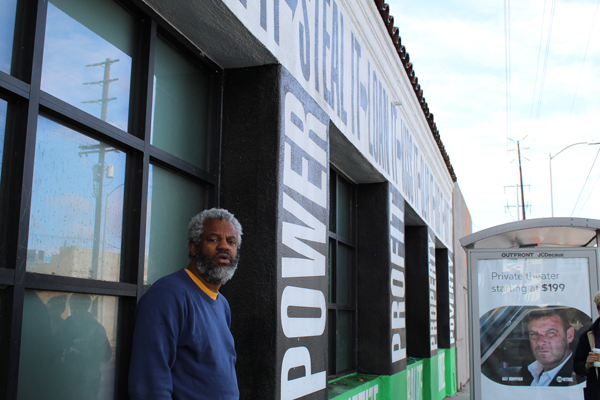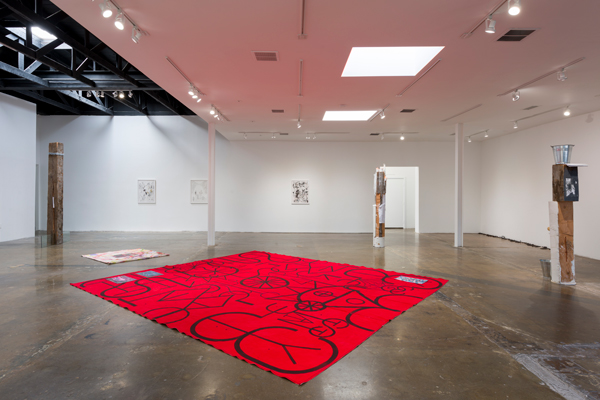A recent Barbara Kruger text mural adorns LAXART—accompanying the relaunch of their newly renovated space. The site-specific work debuted in June and extends until Spring this year. One might not have paid much attention to the building before, but Kruger’s signature Helvetica black text on white commands your attention. It just looks so good. Large fig trees surround the building as you enter the courtyard through a wrought-iron gate. It feels homey, even with Barbara Kruger yelling at you.
The welcoming vibe pervades when I open the door to find Hamza Walker standing, chatting across the room to assistant curator Makayla Bailey in her office. He pauses to say hello, not really knowing who I am. It only takes a moment though for him to realize I’m here to interview him. He is friendly, unassuming and invites me into what I thought to be his office, but he points toward the back to a smaller room, actually more like a closet. He motions me to sit in the larger room that is dominated by a white boardroom table. Walker has just one thing to finish up before we sit down, so I duck out for a quick browse to see the current group exhibition, “Sperm Cult.” Both shows (Kruger) are products of Walker’s curatorial efforts.

Portrait of Hamza Walker (in front of LAXART Kruger mural),image courtesy LAXART
When I return to sit at the large white table, Walker emerges from his office. Dressed casually in black shirt and pants, mussed salt-and-pepper hair and beard, his boyish looks belie his 52 years of age. Walker became executive director of LAXART in 2016, succeeding founder Lauri Firstenberg, who has since opened her own commercial art gallery in LA. He left his long career in Chicago at The Renaissance Society as associate curator and director of education. For over two years now he has lived in California and I wondered if he has been able to keep up with the large pool of LA artists, and how’s it been going at LAXART. He reminds me that he co-curated the Hammer’s biennial Made in L.A. in 2016—probably the best primer for SoCal talent given the infinite studio visits required for the selection process.
LAXART is a nonprofit art organization since 2005, and also refers to itself as an alternative space. What exactly does alternative mean? The word seems like a misnomer these days. Alternative newspapers and music, in essence, no longer exist. They were conceived with the intention of not being “owned” by advertisers, sponsors or a board, and most were started by journalists, actors, musicians or fine artists, depending on the discipline. Walker has pondered this subject before and was more than happy to share his thoughts about what an alternative space means—in any era. He offers enthusiastically, “The rubric of alternative depends on where, depends on when. The founding and forging of alternatives in the mid-1970s and the rise of artist-run spaces is to understand the historical circumstances that brought the need for those spaces.”
A lot of art practices fell outside the scope of the commercial gallery and a need for alternative spaces became necessary, Walker explains to me. The commercial galleries weren’t showing video or performance, “alternative media”—after all, how do you market a performance? Art dealers weren’t willing to take those risks; they needed something for their collectors to buy.
Community is the one thing that seems to be a common denominator throughout the lifespan of alternatives. Walker is passionate about the need and public service these nonprofit organizations provide. He taps his fingers firmly on the table stressing his every syllable: “Insti-tu-tions can-not meet the de-mands of a cre-ative com-munity! The volume of cultural production of what artists are doing and the number of institutions is hopelessly outta whack!” Walker belts this out like a preacher at his pulpit.
Alternative spaces are “self-organizing” and will do what they have to: put on exhibitions in backyards, living rooms, garages, spare bedrooms, moving vehicles. Walker, though, insists that there also is an anti-hierarchical kind of ethos at play here—challenging the structures of institutions. Walker sticks with his theory, that alternative just bends its meaning with the times. From the ’70s to the ’80s, Walker adds, “There was a sociopolitical paradigm shift. Right. The Reagan years. It’s also a cultural paradigm shift. The 1980s was a period that was aware of itself as distinct from the 1960s—and gladly so.” (We really didn’t get to the part why gladly so.)

“Sperm Cult,” installation view, 2018, photo by Ruben Diaz, courtesy LAXART
When Walker joined LAXART, the board included artists. He was glad to continue the tradition—Rodney McMillian, Andrea Bowers and Mary Weatherford are board members presently. LA artist Daniel Joseph Martinez also was central to the founding of LAXART along with Firstenberg. “I still to this day need to sit down with Daniel just to tease out what that history was,” he says, possibly a little chagrined.
Introducing emerging artists is integral to an alternative space’s mission. This is where commercial galleries differed in the past as they tended not to show younger artists with a spare exhibition record. Galleries today seem to strive for the opposite. They are willing to take more chances, even eager to show students—which was unheard of not so long ago. Alternative venues always had that edge over commercial galleries.
Where’s the edge now when art galleries are the ones breaking all the rules? Walker doesn’t feel like he’s competing with the commercial art world. That doesn’t necessarily define alternative in his eyes. Sure, emerging artists are always the practice of any contemporary art nonprofit program, but that’s certainly not the only quest in an alternative space. He’s not tied to any agenda yet in his two years at LAXART. “I prefer to see it left open as a question and responding to again the sociopolitical paradigm shift. Rather than to define the organization as an alternative based on a scramble for young talent about who’s declared hot as a result of sales at Art Basel Miami or Frieze or whatever art fair.”
Los Angeles and its schools produce lots of young artists. Where are they showing? Nonprofit alternative spaces aren’t as pervasive as they used to be in the 1980s. Spaces like the Woman’s Building and the LA Institute of Contemporary Art (LAICA) certainly had a presence and place in time, but they soon fizzled without enough funding. “So where were all these young artists showing? The number of venues at that time could accommodate their work—a small nonprofit space where virgin artists could show. They could be given their shows, out of graduate school, where perhaps they developed their first body of works. So I think LAXART was founded, this is my sense, with picking up that slack.”
Now, 13 years later, the landscape has changed, Walker says. There are numerous spaces for young talent to show (including commercial galleries!). Walker says finding that young talent doesn’t need to be the center of LAXART’s mission. “Now, what then could alternative mean? To me, it’s still is a question. As I assume the reins, yet again, another major sociopolitical paradigm shift,” he laughs.

